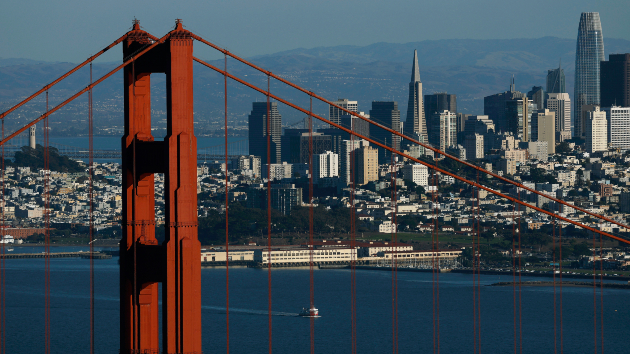‘There’s no healing:’ Thousands of families beg for action on housing after Maui wildfires
Written by ABC Audio ALL RIGHTS RESERVED on November 9, 2023

(NEW YORK) — Alfonso Basurto watched as the home that housed his family of seven burned to the ground in the Maui wildfires on Aug. 8.
He raced to the property to check if some of his children, between the ages of 14 and 21, were there — driving through heavy smoke and under downed power lines to reach them.
He didn’t see their truck in the driveway, meaning they were not there and had safely evacuated. The relief allowed Basurto a moment to survey the small fires igniting on the lawn, the fence around the property going up in flames, the structure of their home ablaze.
“I’m like, ‘Alfie, if you stay here, part of the roof is going to fly off, it’s going to knock you out and then this is all over. Get back in the car and get out of here,'” Basurto recalled himself thinking at the time. “That’s what I did.”
Their five-bedroom house was located right along Lahaina’s busy, tourist-ridden Front Street.
Now, he and the rest of his family are squeezed into a four-bedroom home, paying $9,000 a month, which he said is double what they paid before the fire for a larger home. His three businesses were destroyed in the fire.
Barsuto and his family are one of thousands struggling to find stability three months after the tragedy, on an island that had already been marred by skyrocketing housing and living costs.
State Attorney General Anne Lopez is investigating dozens of reports of rent hikes and evictions following the tragedy, as Hawaii Gov. Josh Green implements an eighth emergency declaration to place restrictions on price gouging on necessities, including rent, food and water.
More than 2,200 structures were burned to the ground in the fire, according to Maui County officials. It left more than 7,000 people in need of shelter after the wildfire.
The majority of what was destroyed that day was affordable housing, “for local, working-class people,” State Representative and Housing Committee member Troy Hasimoto told ABC News.
The more expensive homes were practically untouched, he added.
More than 500 of those families were homeowners, but the vast majority of people affected were renters who were living in multi-generational or multi-family households, he added.
Gov. Green cautioned that it could be up to a two-year wait before property owners can begin to rebuild their homes, worsening an already intense housing crisis on the island.
Hawaii residents have some of the highest housing costs in the nation — 2.5 times higher than the national average — according to the University of Hawaii Economic Research Organization.
The median sales price for a single-family home in Maui currently stands at $1,269,025, up 18% from this time last year, according to the Realtors Association of Maui. Condominiums have a median sale price of $835,000, up 4%.
The median income stands at $88,249, according to the U.S. Census.
Emergency housing is coming to an end, and officials are encouraging residents to find housing and take advantage of rental assistance options as hotels and short-term rentals hope to bring tourists back to the tourism-reliant community.
“The people in the shelters aren’t going to be able to move out of the shelter – to be faced with the rental market that is unrealistic,” said Basurto.
But with some folks juggling a mortgage and rent, others also juggling unemployment — both residents and local legislators are looking for solutions to build Lahaina back better and get people back home.
“I’m not healing,” said Justin Abilay, a Lahaina resident whose family has lived there for 10 generations. “I’m not going to be able to heal until I get home. … There’s no healing out here right now and we’re struggling.”
Community sticks together
Efforts to build cost-free, short-term housing for those who’ve been displaced have begun to pop up around West Maui — with local residents offering their own services and skills to make displaced residents more comfortable.
Basurto, who owns and wishes to donate more than two acres of land, is working on plans to fill his lot with mid-term, rent-free housing the families can stay in for up to two years.
“When things are bad, everyone needs to help in any way that they can,” said Basurto. “I thought the most impact that we could make was to donate our land to create homes.”
They would be geodesic domes, which they have already begun to build as temporary structures for donation hubs and areas to serve as a safe haven against environmental challenges within the burn zone.
The ones built for housing would be semi-permanent structures built to last 20 years or longer, according to Basurto.
For those who are currently unhoused and displaced, and who haven’t found shelter in temporary housing, Basurto and his team at Rebuild Maui will be holding a communal space for the community to gather and pitch their tents for “however long it takes for our community to receive real housing solutions.”
Atom Kasprzycki, who owns an architecture firm with his wife Jennifer, is helping families develop construction plans for their future rebuilding efforts at no cost, as well as assisting with the permitting process to get their plans approved.
Residents interested in the program will be grouped based on their needs and wants, and given group-based designs that can later be personalized. Kasprzycki hopes this will streamline and optimize the process — and his roughly 25 years of experience with zoning laws and lot types will help ease this transition.
“Most people were underinsured, and when you look at the money that they’re going to have to build their home and what current construction costs are — there’s definitely a gap there,” said Kasprzycki in an interview. “So there is a need for inexpensive construction and getting these homes rebuilt at the lowest cost possible.”
Abilay, who has lived in Lahaina all his life and whose ancestors lived in his home before him, is one of the residents receiving these services.
He said the local Lahaina community has been giving him hope — which has been hard to come by with all of the issues surrounding housing, finances, rebuilding and more plaguing the Hawaii region.
“It’s a tight community and this tragedy has shown how much the community cares for each other,” Abilay said.
He continued, “It’s so hard for everybody to hang in there when housing is so limited, rentals are so limited. There’s so much red tape, just trying to get people housed and it feels like those things are trying to separate our community and the community is still standing strong.”
Housing policy as a path forward
Policy makers are scrambling to find solutions, particularly when past housing policies have fallen flat.
In Lahaina, 25% of housing units are listed as short-term rentals, according to the University of Hawaii Economic Research Organization. To the south of Lahaina, that percentage jumps to 41.8%. To the north, it jumps to 87%,
The Housing Committee of the Hawaii State Legislature, led by State Reps. Hasimoto and Micah Aiu, said incentivizing short-term rental owners to turn their properties into long-term rentals is one of their first lines of action.
“We have a humongous housing stock in West Maui, it’s just a matter of a lot of it is short-term rentals,” said Hashimoto. “So, it’s figuring out how to incentivize those short-term rentals to be long-term for at least the next couple of years until we can bring those tax credit projects online.”
The Low-Income Housing Tax Credit Program has been an applauded by legislators. The financing tool allows private developers and non-profits to construct affordable rental units and earn tax credits that are a dollar for dollar reduction in income tax liability.
Housing Committee leaders told ABC News that a thousand affordable housing units are in the pipeline for West Maui. However, now legislators need to figure out how to quickly make these units a reality.
“Now it’s just a matter of how do we get that construction done in a matter of time when there’s going to be tremendous pressure within the construction industry because of the rebuild, because these are technically units that are new,” said Hashimoto.
Aiu and Hashimoto said that addressing pitfalls in the housing processes — building code red tape and allowing for property owners to build more than one structure on their land — is on the top of their agenda.
As residents wait for these efforts to be set into motion, they say they’re waiting for answers.
“We’ve felt like it’s been a… we’ve gotten a lot of silent treatment,” said Abilay.
He continued, “We need federal funding. We need bigger federal agents, more federal financial support, to support the people with their housing needs, with their food insecurities, and getting this debris removed as quickly as possible. That’s what we need from our county, state and federal level.”
Copyright © 2023, ABC Audio. All rights reserved.
 KVSP
KVSP 




